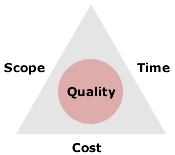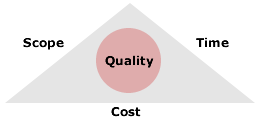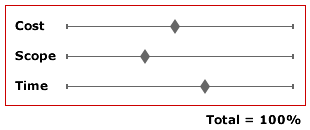- Cost The amount of money it takes to complete any task or task plan. A cost is a value that is associated with time spent working on a task or the amount of something that is consumed while completing a task. In other words, cost is the total amount of money spent while completing all of the work defined in a task plan.
- Quality The point at which completion of a task or a task plan satisfies non-task plan requirements, such as those of an external customer, an executive sponsor, other teams within your organization, and so on. The level of quality is often determined by a combination of cost, scope, and time, plus the resources allocated to a task plan.
- Resources The people, equipment, and material that are used to complete each task in a task plan.
- Scope The overall size of the task plan, including all of its tasks, goals, and requirements.
- Time The duration of any task, it's relationship to other tasks (dependencies), and the importance of getting that task done (critical path).
The three most important elements, in terms of managing a task plan, are time, scope, and cost. Each of them has a limit. There is only so much money with which to pay for and acquire resources. There is only so much time in which the task plan can be completed. And scope must (at some point) be limited in a way that allows the project to be completed on time and on budget.
These three elements work together to provide boundaries to any task plan and help to determine the successful outcome of any project. Typically, one cannot make changes to one of these elements without having to make trade-offs that can affect one or both of the others. You can think of it like this: [cost + time + scope] = 100% of all the things that must come together in order to finish the work that is defined in a task plan. Cost, time, and scope can be any fraction of 100%.
There are a number of ways this relationship can be visualized. The most traditional way is to show them as a triangle, where cost, scope, and time each represent one side, where quality sits in the middle (and therefore depends on cost, scope, and time), and where resources are implied (resources have a cost, resources take time, resources need to be factored into the overall scope of a task plan, and resources play a critical role in affecting the quality of effort):

You could visualize the traditional way with an emphasis on one of the three main elements, for example an emphasis on cost:

You can visualize them as a three sliding components:

Add in quality and resources (to cost, scope, and time) and you have the five key elements integral to any task plan. They are dependent on each other and their sum is often greater than their parts.
It doesn't matter how your organization chooses to visualize this interaction as long as your organization understands that a well-balanced project plan can be completed on time, on budget, and on scope. That a well-balanced project plan will often result in something of high quality. And that resources should only be committed to work on something that will result in something that provides value to its customers.